Bibliometric Analysis of Nature-Based Therapy Research
Abstract
:1. Introduction
2. Materials and Methods
2.1. Design and Data Source
2.2. Data Analysis
3. Results
3.1. Annual Publication Trends
3.2. WoS Categories
3.3. Publications Titles
3.4. Prolific and Influential Co-Authors
3.5. Countries/Regions
3.6. Author Keywords
3.7. Documents
4. Discussion
5. Conclusions
Supplementary Materials
Author Contributions
Funding
Institutional Review Board Statement
Informed Consent Statement
Data Availability Statement
Acknowledgments
Conflicts of Interest
References
- Grooten, M.; Almond, R.E.A. Living Planet Report—2018: Aiming Higher; WWF International: Gland, Switzerland, 2018; ISBN 978-2-940529-90-2. [Google Scholar]
- Hartig, T.; Mitchell, R.; de Vries, S.; Frumkin, H. Nature and Health. Annu. Rev. Public Health 2014, 35, 207–228. [Google Scholar] [CrossRef] [PubMed]
- Zhang, Z.; Wang, P.; Gao, Y.; Ye, B. Current Development Status of Forest Therapy in China. Healthcare 2020, 8, 61. [Google Scholar] [CrossRef] [PubMed]
- Song, C.; Ikei, H.; Miyazaki, Y. Physiological Effects of Nature Therapy: A Review of the Research in Japan. Int. J. Environ. Res. Public. Health 2016, 13, 781. [Google Scholar] [CrossRef] [PubMed]
- Gabrielsen, L.E.; Harper, N.J. The Role of Wilderness Therapy for Adolescents in the Face of Global Trends of Urbanization and Technification. Int. J. Adolesc. Youth 2018, 23, 409–421. [Google Scholar] [CrossRef]
- Pichler, C.; Freidl, J.; Bischof, M.; Kiem, M.; Weissboeck-Erdheim, R.; Huber, D.; Squarra, G.; Murschetz, P.C.; Hartl, A. Mountain Hiking vs. Forest Therapy: A Study Protocol of Novel Types of Nature-Based Intervention. Int. J. Environ. Res. Public Health 2022, 19, 3888. [Google Scholar] [CrossRef]
- Lu, N.; Song, C.; Kuronuma, T.; Ikei, H.; Miyazaki, Y.; Takagaki, M. The Possibility of Sustainable Urban Horticulture Based on Nature Therapy. Sustainability 2020, 12, 5058. [Google Scholar] [CrossRef]
- Harper, N.J. Outdoor Therapies: An Introduction to Practices, Possibilities, and Critical Perspectives; Routledge/Taylor & Francis Group: New York, NY, USA; Abingdon, UK, 2020; ISBN 978-0-367-36570-7. [Google Scholar]
- Revell, S.; Duncan, E.; Cooper, M. Helpful Aspects of Outdoor Therapy Experiences: An Online Preliminary Investigation. Couns. Psychother. Res. 2014, 14, 281–287. [Google Scholar] [CrossRef]
- Rutko, E.A.; Gillespie, J. Where’s the Wilderness in Wilderness Therapy? J. Exp. Educ. 2013, 36, 218–232. [Google Scholar] [CrossRef]
- Harper, N.J.; Fernee, C.R.; Gabrielsen, L.E. Nature’s Role in Outdoor Therapies: An Umbrella Review. Int. J. Environ. Res. Public Health 2021, 18, 5117. [Google Scholar] [CrossRef]
- Kim, J.-G.; Shin, W.-S. Forest Therapy Alone or with a Guide: Is There a Difference between Self-Guided Forest Therapy and Guided Forest Therapy Programs? Int. J. Environ. Res. Public Health 2021, 18, 6957. [Google Scholar] [CrossRef]
- Yu, C.-P.; Chen, H.-T.; Chao, P.-H.; Yin, J.; Tsai, M.-J. The Role of Social Context in Physiological and Psychological Restoration in a Forest: Case Study of a Guided Forest Therapy Program in Taiwan. Int. J. Environ. Res. Public Health 2021, 18, 10076. [Google Scholar] [CrossRef]
- Hansen, M.M.; Jones, R.; Tocchini, K. Shinrin-Yoku (Forest Bathing) and Nature Therapy: A State-of-the-Art Review. Int. J. Environ. Res. Public Health 2017, 14, 851. [Google Scholar] [CrossRef]
- Kotera, Y.; Richardson, M.; Sheffield, D. Effects of Shinrin-Yoku (Forest Bathing) and Nature Therapy on Mental Health: A Systematic Review and Meta-Analysis. Int. J. Ment. Health Addict. 2022, 20, 337–361. [Google Scholar] [CrossRef]
- Mao, G.-X.; Cao, Y.-B.; Lan, X.-G.; He, Z.-H.; Chen, Z.-M.; Wang, Y.-Z.; Hu, X.-L.; Lv, Y.-D.; Wang, G.-F.; Yan, J. Therapeutic Effect of Forest Bathing on Human Hypertension in the Elderly. J. Cardiol. 2012, 60, 495–502. [Google Scholar] [CrossRef] [PubMed]
- Mohan, A.; Malhotra, S.; Narayanan, M.; White, H.; Gaffney, H. PROTOCOL: The Effectiveness of Wilderness Therapy and Adventure Learning in Reducing Anti-Social and Offending Behaviour in Children and Young People at Risk of Offending. Campbell Syst. Rev. 2022, 18, e1270. [Google Scholar] [CrossRef]
- Fernee, C.R.; Gabrielsen, L.E.; Andersen, A.J.W.; Mesel, T. Unpacking the Black Box of Wilderness Therapy: A Realist Synthesis. Qual. Health Res. 2017, 27, 114–129. [Google Scholar] [CrossRef] [PubMed]
- Kraft, M.; Cornelius-White, J. Adolescent Experiences in Wilderness Therapy: A Systematic Review of Qualitative Studies. J. Creat. Ment. Health 2020, 15, 343–352. [Google Scholar] [CrossRef]
- Beck, N.; Wong, J.S. A Meta-Analysis of the Effects of Wilderness Therapy on Delinquent Behaviors Among Youth. Crim. Justice Behav. 2022, 49, 700–729. [Google Scholar] [CrossRef]
- Cooley, S.J.; Jones, C.R.; Kurtz, A.; Robertson, N. “Into the Wild”: A Meta-Synthesis of Talking Therapy in Natural Outdoor Spaces. Clin. Psychol. Rev. 2020, 77, 101841. [Google Scholar] [CrossRef]
- Cooley, S.J.; Jones, C.R.; Moss, D.; Robertson, N. Organizational Perspectives on Outdoor Talking Therapy: Towards a Position of “Environmental Safe Uncertainty”. Br. J. Clin. Psychol. 2022, 61, 132–156. [Google Scholar] [CrossRef]
- Clatworthy, J.; Hinds, J.; Camic, P.M. Gardening as a Mental Health Intervention: A Review. Ment. Health Rev. J. 2013, 18, 214–225. [Google Scholar] [CrossRef]
- Whear, R.; Coon, J.T.; Bethel, A.; Abbott, R.; Stein, K.; Garside, R. What Is the Impact of Using Outdoor Spaces Such as Gardens on the Physical and Mental Well-Being of Those with Dementia? A Systematic Review of Quantitative and Qualitative Evidence. J. Am. Med. Dir. Assoc. 2014, 15, 697–705. [Google Scholar] [CrossRef] [PubMed]
- Kamioka, H.; Tsutani, K.; Yamada, M.; Park, H.; Okuizumi, H.; Honda, T.; Okada, S.; Park, S.-J.; Kitayuguchi, J.; Abe, T.; et al. Effectiveness of Horticultural Therapy: A Systematic Review of Randomized Controlled Trials. Complement. Ther. Med. 2014, 22, 930–943. [Google Scholar] [CrossRef] [PubMed]
- Stern, C.; Chur-Hansen, A. An Umbrella Review of the Evidence for Equine-Assisted Interventions. Aust. J. Psychol. 2019, 71, 361–374. [Google Scholar] [CrossRef]
- Cooke, B.; Farrington, D. The Effectiveness of Dog-Training Programs in Prison. Prison J. 2016, 96, 854–876. [Google Scholar] [CrossRef]
- Azevedo, A. A New Theoretical Framework for Therapeutic Landscapes: Coastal (Blue), Forest (Green), Spiritual “Power Spots” (Gold) and Wilderness (Dark/White). J. Spat. Organ. Dyn. 2020, 8, 29–51. [Google Scholar]
- Brooke, K.; Williams, A. Iceland as a Therapeutic Landscape: White Wilderness Spaces for Well-Being. Geojournal 2021, 86, 1275–1285. [Google Scholar] [CrossRef]
- Satariano, B. Blue Therapeutic Spaces on Islands: Coastal Landscapes and Their Impact on the Health and Wellbeing of People in Malta. Isl. Stud. J. 2019, 14, 245–260. [Google Scholar] [CrossRef]
- Pijpker, R.; Veen, E.J.; Vaandrager, L.; Koelen, M.; Bauer, G.F. Developing an Intervention and Evaluation Model of Outdoor Therapy for Employee Burnout: Unraveling the Interplay Between Context, Processes, and Outcomes. Front. Psychol. 2022, 13, 785697. [Google Scholar] [CrossRef]
- Szczepanska-Gieracha, J.; Cieslik, B.; Serweta, A.; Klajs, K. Virtual Therapeutic Garden: A Promising Method Supporting the Treatment of Depressive Symptoms in Late-Life: A Randomized Pilot Study. J. Clin. Med. 2021, 10, 1942. [Google Scholar] [CrossRef]
- Picton, C.; Fernandez, R.; Moxham, L.; Patterson, C.F. Experiences of Outdoor Nature-Based Therapeutic Recreation Programs for Persons with a Mental Illness: A Qualitative Systematic Review. Jbi Evid. Synth. 2020, 18, 1820–1869. [Google Scholar] [CrossRef] [PubMed]
- Kondo, M.C.; South, E.C.; Branas, C.C. Nature-Based Strategies for Improving Urban Health and Safety. J. Urban Health Bull. N. Y. Acad. Med. 2015, 92, 800–814. [Google Scholar] [CrossRef] [PubMed]
- Di Carmine, F.; Berto, R. Contact with Nature Can Help ADHD Children to Cope with Their Symptoms. A State of the Evidence and Future Lines of Research. Vis. Sustain. 2020, 14, 1–11. [Google Scholar] [CrossRef]
- Sprague, N.; Berrigan, D.; Ekenga, C.C. An Analysis of the Educational and Health-Related Benefits of Nature-Based Environmental Education in Low-Income Black and Hispanic Children. Health Equity 2020, 4, 198–210. [Google Scholar] [CrossRef] [PubMed]
- Chan, Y.T.; Lau, H.Y.; Chan, W.Y.; Cheung, C.W.; Lui, W.; Chane-Thu, Y.S.J.; Dai, W.L.; To, K.C.; Cheng, H.L. Adventure Therapy for Child, Adolescent, and Young Adult Cancer Patients: A Systematic Review. Support. Care Cancer 2021, 29, 35–48. [Google Scholar] [CrossRef]
- Gill, E.; Goldenberg, M.; Starnes, H.; Phelan, S. Outdoor Adventure Therapy to Increase Physical Activity in Young Adult Cancer Survivors. J. Psychosoc. Oncol. 2016, 34, 184–199. [Google Scholar] [CrossRef]
- Meneguzzo, F.; Albanese, L.; Antonelli, M.; Baraldi, R.; Becheri, F.R.; Centritto, F.; Donelli, D.; Finelli, F.; Firenzuoli, F.; Margheritini, G.; et al. Short-Term Effects of Forest Therapy on Mood States: A Pilot Study. Int. J. Environ. Res. Public Health 2021, 18, 9509. [Google Scholar] [CrossRef]
- Bielinis, E.; Jaroszewska, A.; Lukowski, A.; Takayama, N. The Effects of a Forest Therapy Programme on Mental Hospital Patients with Affective and Psychotic Disorders. Int. J. Environ. Res. Public Health 2020, 17, 118. [Google Scholar] [CrossRef]
- Chun, M.H.; Chang, M.C.; Lee, S.-J. The Effects of Forest Therapy on Depression and Anxiety in Patients with Chronic Stroke. Int. J. Neurosci. 2017, 127, 199–203. [Google Scholar] [CrossRef]
- Han, J.-W.; Choi, H.; Jeon, Y.-H.; Yoon, C.-H.; Woo, J.-M.; Kim, W. The Effects of Forest Therapy on Coping with Chronic Widespread Pain: Physiological and Psychological Differences between Participants in a Forest Therapy Program and a Control Group. Int. J. Environ. Res. Public Health 2016, 13, 255. [Google Scholar] [CrossRef]
- Donthu, N.; Kumar, S.; Mukherjee, D.; Pandey, N.; Lim, W.M. How to Conduct a Bibliometric Analysis: An Overview and Guidelines. J. Bus. Res. 2021, 133, 285–296. [Google Scholar] [CrossRef]
- Wang, X.; Gong, X.-F.; Xiong, K.-X.; Guo, D.-S.; Liu, L.-J.; Lin, C.-M.; Chang, W.-Y. Mapping of Research in the Field of Forest Therapy-Related Issues: A Bibliometric Analysis for 2007-2021. Front. Psychol. 2022, 13, 930713. [Google Scholar] [CrossRef]
- Huang, X.; Yang, Z.; Zhang, J.; Wang, R.; Fan, J.; Zhang, H.; Xu, R.; Li, X.; Yu, S.; Long, L.; et al. A Bibliometric Analysis Based on Web of Science: Current Perspectives and Potential Trends of SMAD7 in Oncology. Front. Cell Dev. Biol. 2022, 9, 712732. [Google Scholar] [CrossRef] [PubMed]
- Shi, J.; Gao, Y.; Ming, L.; Yang, K.; Sun, Y.; Chen, J.; Shi, S.; Geng, J.; Li, L.; Wu, J.; et al. A Bibliometric Analysis of Global Research Output on Network Meta-Analysis. BMC Med. Inform. Decis. Mak. 2021, 21, 144. [Google Scholar] [CrossRef] [PubMed]
- Yu, Y.; Li, Y.; Zhang, Z.; Gu, Z.; Zhong, H.; Zha, Q.; Yang, L.; Zhu, C.; Chen, E. A Bibliometric Analysis Using VOSviewer of Publications on COVID-19. Ann. Transl. Med. 2020, 8, 816. [Google Scholar] [CrossRef] [PubMed]
- Price, D.D.S. A General Theory of Bibliometric and Other Cumulative Advantage Processes. J. Am. Soc. Inf. Sci. 1976, 27, 292–306. [Google Scholar] [CrossRef]
- Dobrov, G.M.; Randolph, R.H.; Rauch, W.D. New Options for Team Research via International Computer Networks. Scientometrics 1979, 1, 387–404. [Google Scholar] [CrossRef]
- DeShazo, J.P.; LaVallie, D.L.; Wolf, F.M. Publication Trends in the Medical Informatics Literature: 20 Years of “Medical Informatics” in MeSH. BMC Med. Inform. Decis. Mak. 2009, 9, 7. [Google Scholar] [CrossRef]
- Goffman, W.; Warren, K.S. Dispersion of Papers among Journals Based on a Mathematical Analysis of Two Diverse Medical Literatures. Nature 1969, 221, 1205–1207. [Google Scholar] [CrossRef]
- Nash-Stewart, C.E.; Kruesi, L.M.; Del Mar, C.B. Does Bradford’s Law of Scattering Predict the Size of the Literature in Cochrane Reviews? J. Med. Libr. Assoc. JMLA 2012, 100, 135–138. [Google Scholar] [CrossRef]
- Venable, G.T.; Shepherd, B.A.; Loftis, C.M.; McClatchy, S.G.; Roberts, M.L.; Fillinger, M.E.; Tansey, J.B.; Klimo, P. Bradford’s Law: Identification of the Core Journals for Neurosurgery and Its Subspecialties. J. Neurosurg. 2016, 124, 569–579. [Google Scholar] [CrossRef] [PubMed]
- Venable, G.T.; Shepherd, B.A.; Roberts, M.L.; Taylor, D.R.; Khan, N.R.; Klimo, P. An Application of Bradford’s Law: Identification of the Core Journals of Pediatric Neurosurgery and a Regional Comparison of Citation Density. Childs Nerv. Syst. 2014, 30, 1717–1727. [Google Scholar] [CrossRef] [PubMed]
- Kushairi, N.; Ahmi, A. Flipped Classroom in the Second Decade of the Millenia: A Bibliometrics Analysis with Lotka’s Law. Educ. Inf. Technol. 2021, 26, 4401–4431. [Google Scholar] [CrossRef] [PubMed]
- Yie, K.-Y.; Chien, T.-W.; Chen, C.-H.; Yeh, Y.-T.; Lin, J.-C.J.; Lai, F.-J. Suitability of H- and x-Indices for Evaluating Authors’ Individual Research Achievements in a given Short Period of Years: A Bibliometric Analysis. Medicine (Baltimore) 2021, 100, e25016. [Google Scholar] [CrossRef] [PubMed]
- Hirsch, J.E. An Index to Quantify an Individual’s Scientific Research Output. Proc. Natl. Acad. Sci. USA 2005, 102, 16569–16572. [Google Scholar] [CrossRef]
- Rodrigues-Santana, L.; Adsuar, J.C.; Denche-Zamorano, Á.; Vega-Muñoz, A.; Salazar-Sepúlveda, G.; Contreras-Barraza, N.; Galán-Arroyo, C.; Louro, H. Bibliometric Analysis of Studies on Whole Body Electromyostimulation. Biology 2022, 11, 1205. [Google Scholar] [CrossRef]
- Zipf, G.K. Selected Studies of the Principle of Relative Frequency in Language; Harvard University Press: Cambridge, MA, USA, 2013; ISBN 978-0-674-43492-9. [Google Scholar]
- Contreras-Barraza, N.; Madrid-Casaca, H.; Salazar-Sepúlveda, G.; Garcia-Gordillo, M.Á.; Adsuar, J.C.; Vega-Muñoz, A. Bibliometric Analysis of Studies on Coffee/Caffeine and Sport. Nutrients 2021, 13, 3234. [Google Scholar] [CrossRef]
- Flach, E. The significance of the forest for the therapeutic value of the German low mountain range. Dtsch. Med. Wochenschr. 1937, 63, 628–632. [Google Scholar] [CrossRef]
- Annerstedt, M.; Wahrborg, P. Nature-Assisted Therapy: Systematic Review of Controlled and Observational Studies. Scand. J. Public Health 2011, 39, 371–388. [Google Scholar] [CrossRef]
- Lee, J.; Tsunetsugu, Y.; Takayama, N.; Park, B.-J.; Li, Q.; Song, C.; Komatsu, M.; Ikei, H.; Tyrvainen, L.; Kagawa, T.; et al. Influence of Forest Therapy on Cardiovascular Relaxation in Young Adults. Evid. Based Complement. Alternat. Med. 2014, 2014, 834360. [Google Scholar] [CrossRef]
- Liang, Y.-D.; Li, Y.; Zhao, J.; Wang, X.-Y.; Zhu, H.-Z.; Chen, X.-H. Study of Acupuncture for Low Back Pain in Recent 20 Years: A Bibliometric Analysis via CiteSpace. J. Pain Res. 2017, 10, 951–964. [Google Scholar] [CrossRef] [PubMed]
- Ali, Q.; Heldal, I.; Helgesen, C.G. A Bibliometric Analysis of Virtual Reality-Aided Vision Therapy. In Studies in Health Technology and Informatics; Mantas, J., Gallos, P., Zoulias, E., Hasman, A., Househ, M.S., Diomidous, M., Liaskos, J., Charalampidou, M., Eds.; IOS Press: Amsterdam, The Netherlands, 2022; ISBN 978-1-64368-290-7. [Google Scholar]
- Zyoud, S.H.; Al-Jabi, S.W. Mapping the Situation of Research on Coronavirus Disease-19 (COVID-19): A Preliminary Bibliometric Analysis during the Early Stage of the Outbreak. BMC Infect. Dis. 2020, 20, 561. [Google Scholar] [CrossRef] [PubMed]
- Pawassar, C.M.; Tiberius, V. Virtual Reality in Health Care: Bibliometric Analysis. JMIR Serious Games 2021, 9, e32721. [Google Scholar] [CrossRef] [PubMed]
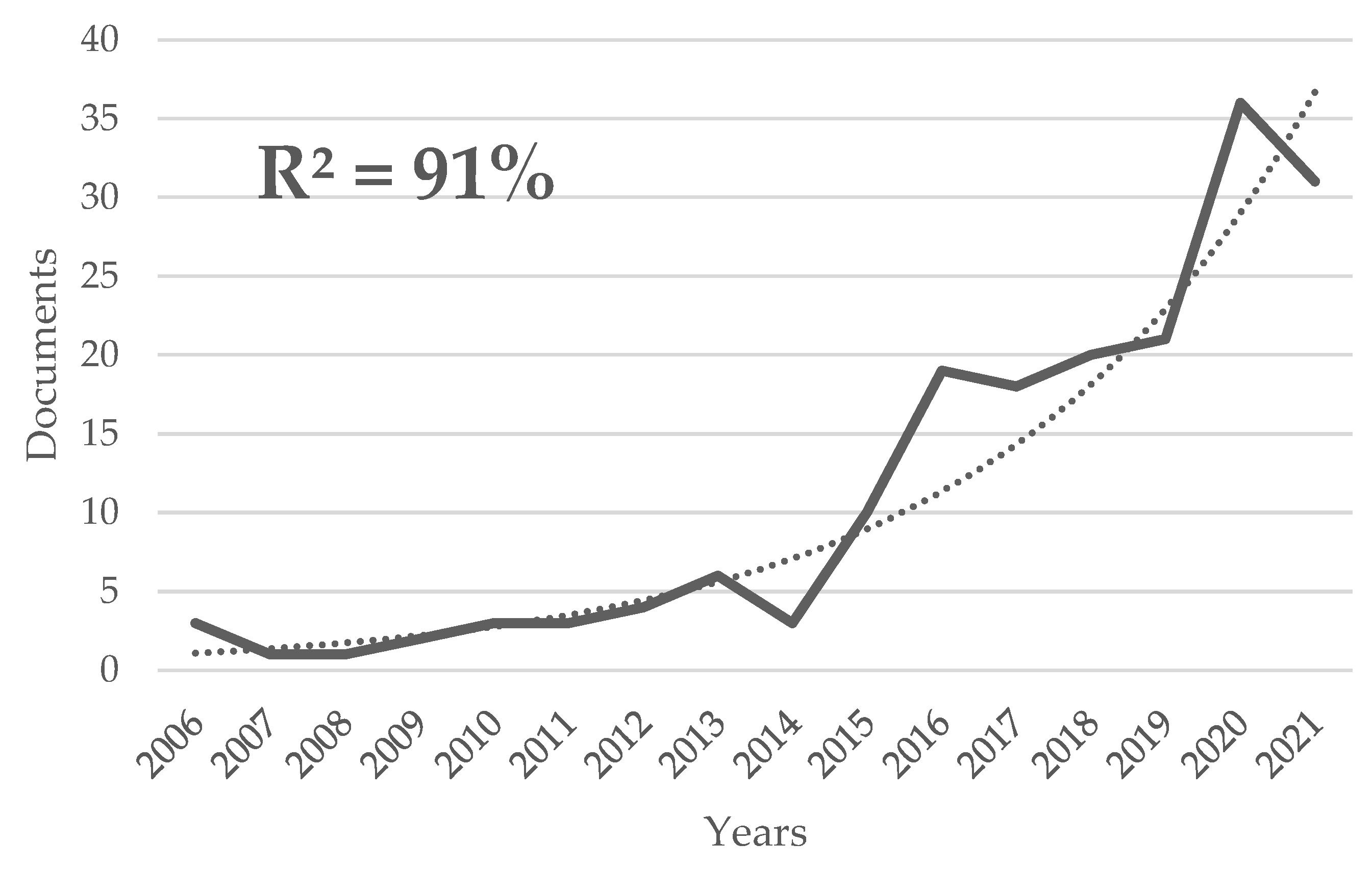
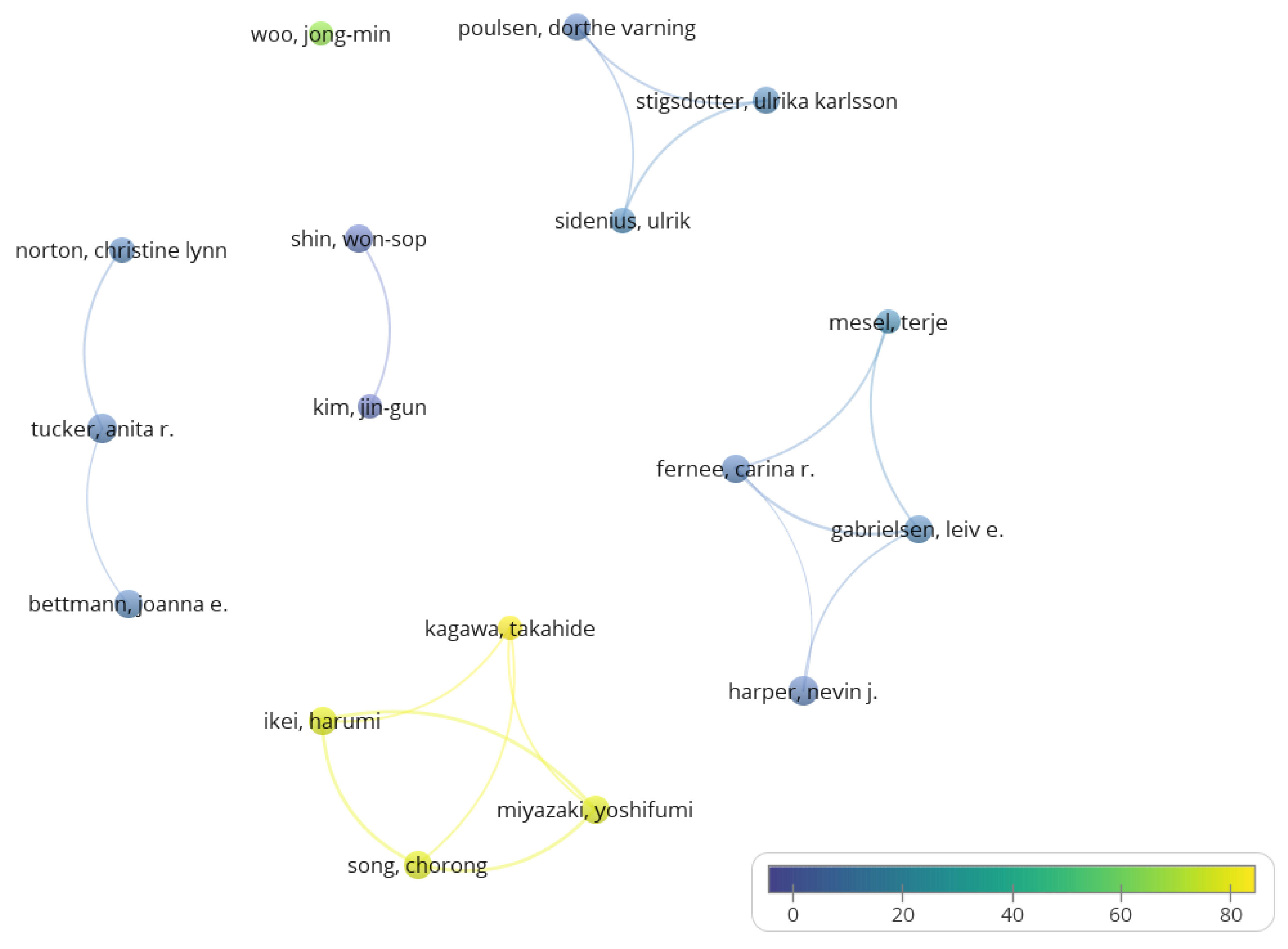
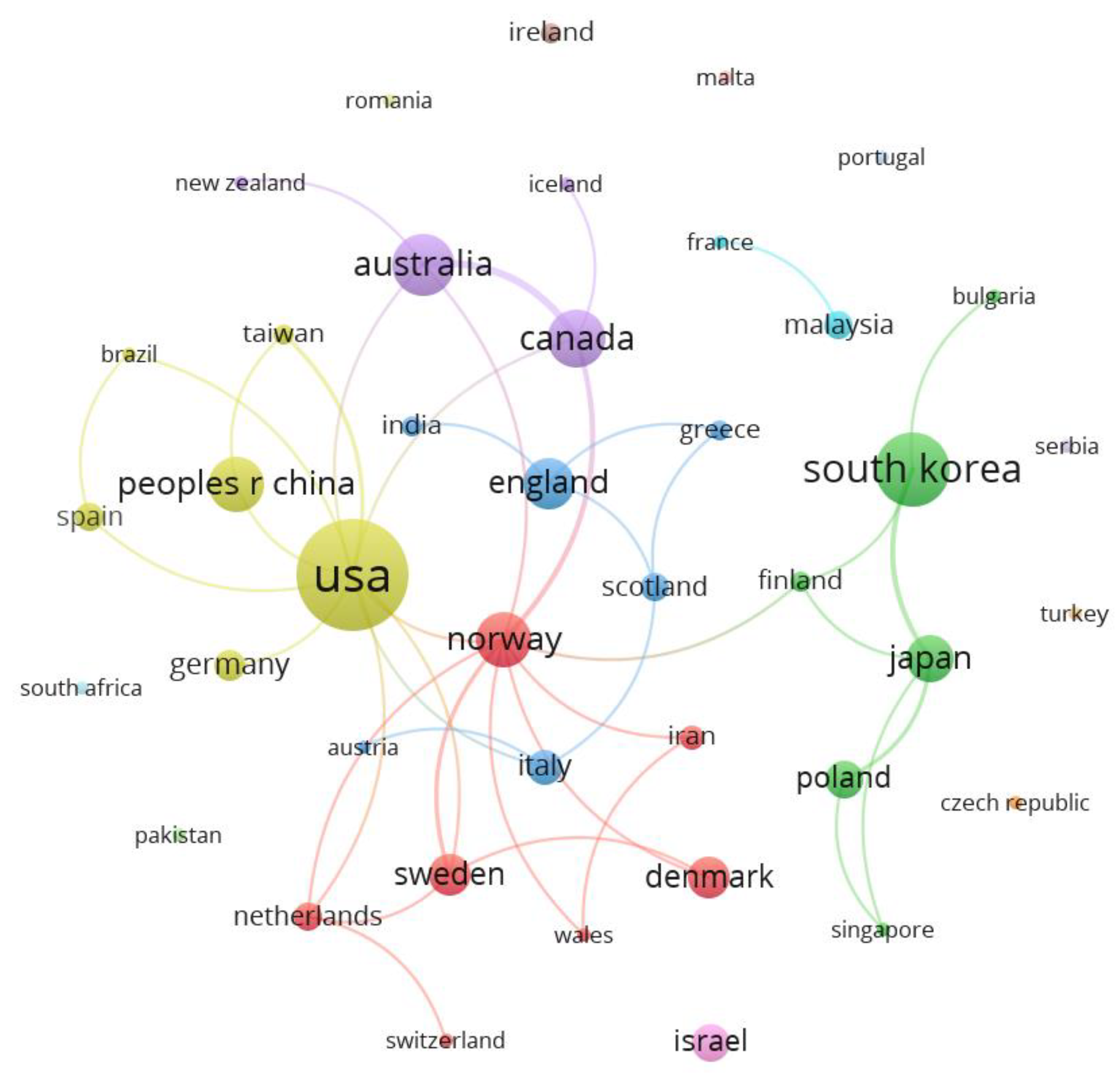
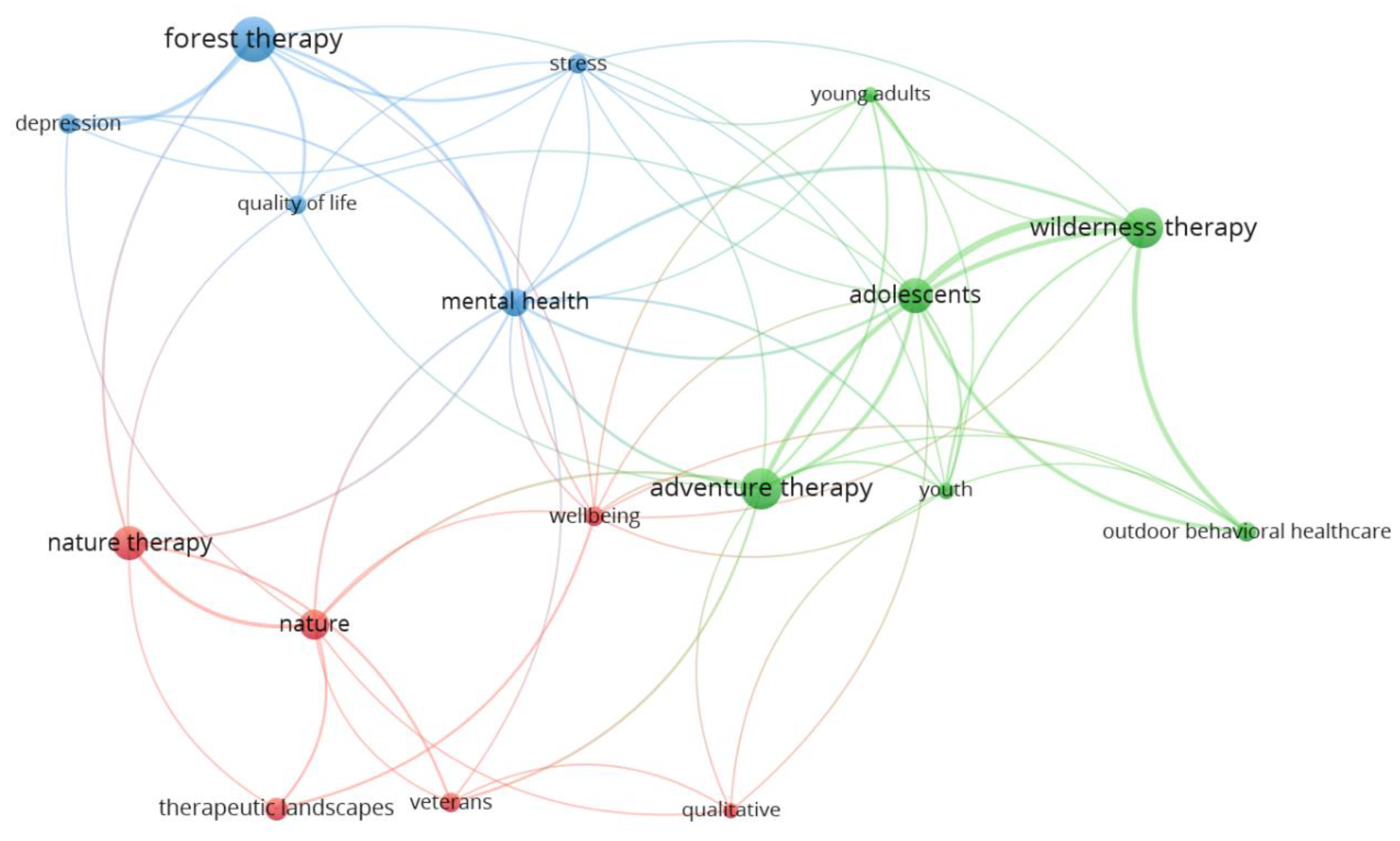
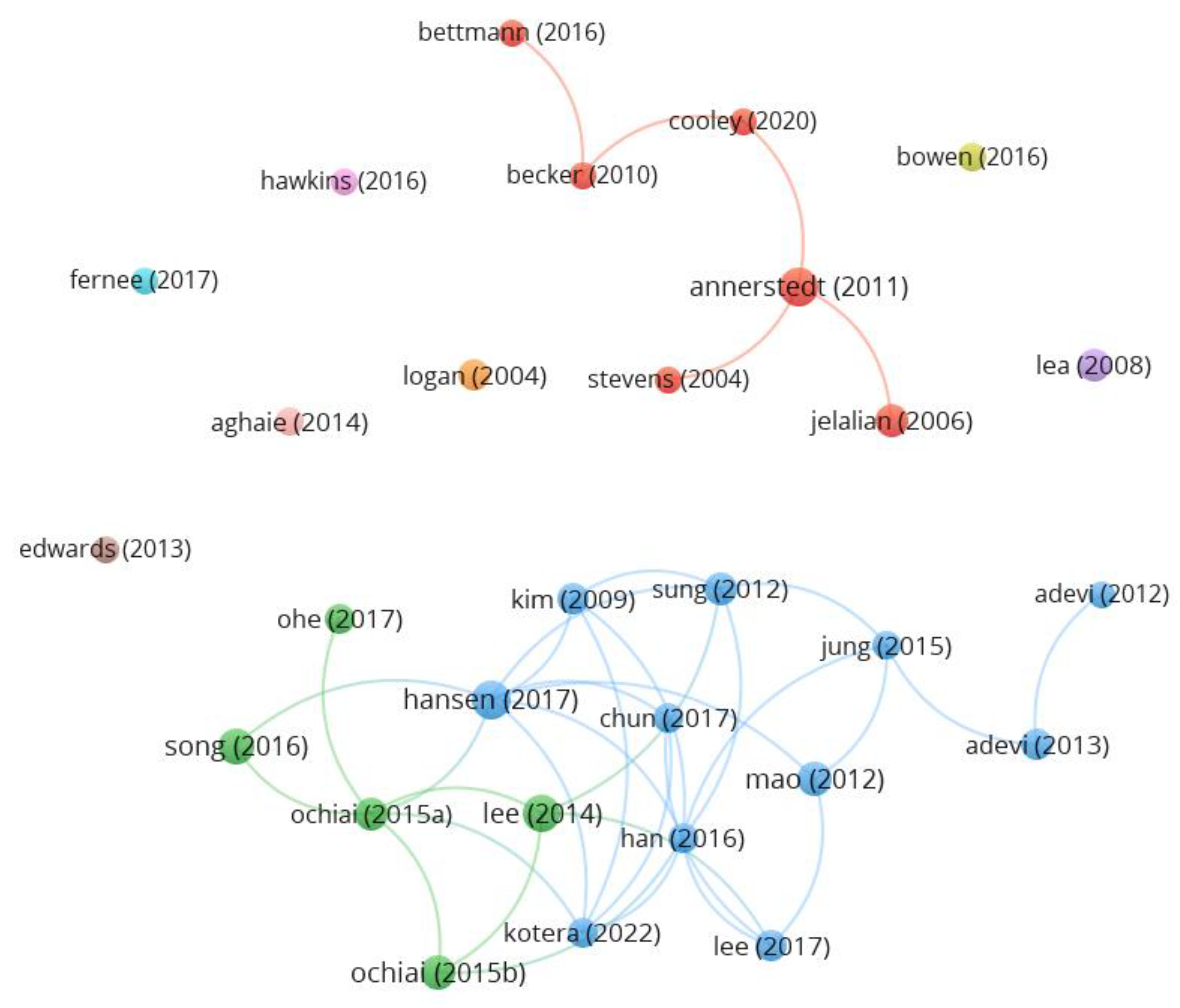
| Web of Science Categories | Number of Documents |
|---|---|
| Public, Environmental, and Occupational Health | 38 |
| Environmental Sciences | 33 |
| Psychology, Clinical | 30 |
| Environmental Studies | 20 |
| Forestry | 20 |
| Journals (Publisher) | Docs | %Docs | Cites | JIF/JCI | Q | %OA |
|---|---|---|---|---|---|---|
| International Journal of Environmental Research and Public Health (MDPI) | 33 | 13.9 | 824 | 4.614 (JIF) | Q1 | 95 |
| Urban Forestry & Urban Greening (Elsevier GMBH) | 13 | 5.5 | 293 | 5.766 (JIF) | Q1 | 10.2 |
| Journal of Adventure Education and Outdoor Learning (Routledge Journals, Taylor & Francis) | 7 | 2.9 | 22 | 0.97 (JCI) | Q2 (JCI) | 15.8 |
| Journal of Experiential Education (Sage Publications) | 7 | 2.9 | 51 | 0.99 (JCI) | Q2 (JCI) | 7 |
| Contemporary Family Therapy (Springer) | 6 | 2.5 | 43 | 0.36 (JCI) | Q3 (JCI) | 4.8 |
| Frontiers in Psychology (Frontiers Media) | 6 | 2.5 | 6 | 4.232 (JIF) | Q1 | 99.5 |
| Women & Therapy (Routledge Journals, Taylor & Francis) | 6 | 2.5 | 63 | 1.484 (JIF) | Q3 | 1.2 |
| Bradford’s Zones | Journals (Publishers) | Docs | Cit | %Cit | JIF | Q. | %OA |
|---|---|---|---|---|---|---|---|
| Core | International Journal of Environmental Research and Public Health (MDPI) | 33 | 824 | 23.4 | 4.614 | Q1 | 95 |
| Urban Forestry & Urban Greening (Elsevier GMBH) | 13 | 293 | 8.3 | 5.766 | Q1 | 10.2 | |
| Zone I | Scandinavian Journal of Public Health (Sage Publications) | 1 | 171 | 4.9 | 3.199 | Q2 | 33.2 |
| Evidence-Based Complementary and Alternative Medicine (Hindawi) | 1 | 147 | 4.2 | 2.650 | Q3 | 98.7 | |
| Journal of Cardiology (Elsevier) | 1 | 103 | 2.9 | 2.974 | Q3 | 8 | |
| Child & Youth Care Forum (Springer) | 4 | 91 | 2.6 | 2.203 | Q3 | 18.8 | |
| International Journal of Obesity (Springer Nature) | 1 | 91 | 2.6 | 5.551 | Q2 | 23 | |
| Clinical and Experimental Hypertension (Taylor & Francis) | 1 | 90 | 2.6 | 2.088 | Q4 | 3.8 | |
| Area (Wiley) | 1 | 83 | 2.4 | 2.057 | Q3 | 24.9 | |
| BMJ—British Medical Journal (BMJ Publishing Group) | 1 | 77 | 2.2 | 93.467 | Q1 | 81.9 | |
| Journal of Child and Family Studies (Springer) | 3 | 71 | 2.0 | 2.784 | Q2 | 10.8 | |
| Psychiatry Investigation (Korean Neuropsychiatric Assoc) | 1 | 67 | 1.9 | 3.202 | Q3 | 99.5 | |
| Women & Therapy (Routledge Journals, Taylor & Francis) | 6 | 63 | 1.8 | 1.484 | Q3 | 1.2 | |
| International Journal of Neuroscience (Taylor & Francis) | 1 | 62 | 1.8 | 2.590 | Q4 | 2.1 |
| Co-authors (Most Cited Documents) | Affiliation/Country-Region | Documents | Citations | Cit/Doc |
|---|---|---|---|---|
| Ikei, Harumi * | Chiba University/Japan | 8 | 597 | 75 |
| Miyazaki, Yoshifumi * | Chiba University/Japan | 8 | 597 | 75 |
| Song, Chorong * | Kongju National University/South Korea | 8 | 597 | 75 |
| Kagawa, Takahide * | Chiba University/Japan | 4 | 382 | 96 |
| Woo, Jong-Min * | Inje University/South Korea | 4 | 251 | 63 |
| Gabrielsen, Leiv E. | Sorlandet Sykehus/Norway | 8 | 100 | 13 |
| Tucker, Anita R. | University of New Hampshire/USA | 9 | 92 | 10 |
| Bettmann, Joanna E. | University of Utah/USA | 8 | 87 | 11 |
| Fernee, Carina R. | University of Agder/Norway | 8 | 78 | 10 |
| Harper, Nevin J. | University of Victoria/Canada | 9 | 78 | 9 |
| Stigsdotter, Ulrika Karlsson | University of Copenhagen/Denmark | 6 | 76 | 13 |
| Sidenius, Ulrik | University of Copenhagen/Denmark | 5 | 68 | 14 |
| Poulsen, Dorthe Varning | University of Copenhagen/Denmark | 7 | 64 | 9 |
| Mesel, Terje | University of Agder/Norway | 4 | 63 | 16 |
| Norton, Christine Lynn | Texas State University System/USA | 5 | 55 | 11 |
| Shin, Won-Sop | Chungbuk National University/South Korea | 8 | 42 | 5 |
| Kim, Jin-Gun | Chungbuk National University/South Korea | 4 | 19 | 5 |
Disclaimer/Publisher’s Note: The statements, opinions and data contained in all publications are solely those of the individual author(s) and contributor(s) and not of MDPI and/or the editor(s). MDPI and/or the editor(s) disclaim responsibility for any injury to people or property resulting from any ideas, methods, instructions or products referred to in the content. |
© 2023 by the authors. Licensee MDPI, Basel, Switzerland. This article is an open access article distributed under the terms and conditions of the Creative Commons Attribution (CC BY) license (https://creativecommons.org/licenses/by/4.0/).
Share and Cite
Rodríguez-Redondo, Y.; Denche-Zamorano, A.; Muñoz-Bermejo, L.; Rojo-Ramos, J.; Adsuar, J.C.; Castillo-Paredes, A.; Vega-Muñoz, A.; Barrios-Fernandez, S. Bibliometric Analysis of Nature-Based Therapy Research. Healthcare 2023, 11, 1249. https://doi.org/10.3390/healthcare11091249
Rodríguez-Redondo Y, Denche-Zamorano A, Muñoz-Bermejo L, Rojo-Ramos J, Adsuar JC, Castillo-Paredes A, Vega-Muñoz A, Barrios-Fernandez S. Bibliometric Analysis of Nature-Based Therapy Research. Healthcare. 2023; 11(9):1249. https://doi.org/10.3390/healthcare11091249
Chicago/Turabian StyleRodríguez-Redondo, Yeray, Angel Denche-Zamorano, Laura Muñoz-Bermejo, Jorge Rojo-Ramos, Jose Carmelo Adsuar, Antonio Castillo-Paredes, Alejandro Vega-Muñoz, and Sabina Barrios-Fernandez. 2023. "Bibliometric Analysis of Nature-Based Therapy Research" Healthcare 11, no. 9: 1249. https://doi.org/10.3390/healthcare11091249









